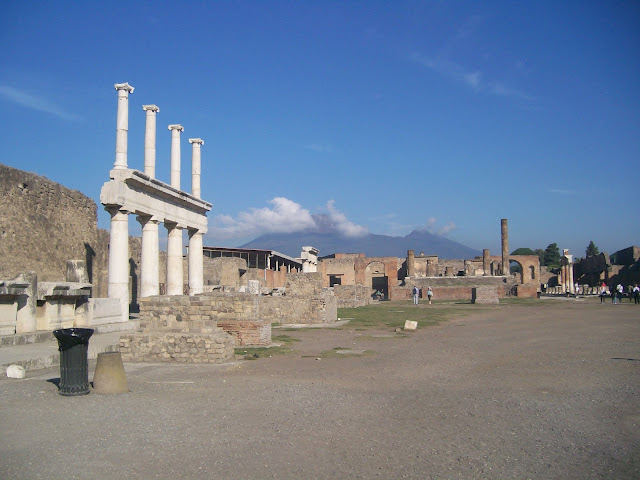Pompeii for Senior Students - and the rest of us
I've been to Pompeii twice - and both times have seen it through the eyes of a teacher - searching for what's on the NSW HSC Syllabus and photographing/videoing each and every 'dot point'.
It would be great just to mooch around Pompeii and see it without this lens, which can sometimes intrude on the enjoyment - but then I get to re-live it again and again when I show my images to my classes.
It would be great just to mooch around Pompeii and see it without this lens, which can sometimes intrude on the enjoyment - but then I get to re-live it again and again when I show my images to my classes.
The Geographical context - Vesuvius looms large over the Forum. Temple of Apollo is on the left.
Streetscape - Via Dell Abbondanza (or 'street of abundance') - one of Pompeii's main streets
Private Buildings: The impluvium of the House of the Faun - with replica faun statue - the original is in the Naples Archaeological Museum
Public Buildings: The Basilica - centre of Pompeii's legal/political activities
The Economy: The Macellum (market). This circular area was once a fish pond where fish were placed and then sold
Everyday Life: The amphitheatre - scene of the riots of AD59 between Pompeii and Nuceria - resulting in Emperor Nero banning all games at this theatre for ten years.
Everyday life: Food and dining - the thermopolium of vetitius placidus
There is so much to learn about Pompeii - it is often overwhelming for students. The NSW HSC demands comprehensive coverage of everything from the geography of Campania to foreign cult worship. I can only imagine what it must be like for a tourist who has heard stories of Pompeii and the eruption of AD79 but knows nothing about the site and its buildings.
I would strongly advise anyone wanting to visit Pompeii to read up on it before you go. Even Wikipedia is a good starting point - it's better than nothing at all. I use Brennan and Lazer's "Pompeii and Herculaneum: Interpreting the Evidence" as a classroom textbook, as well as Bradley's 'Cities of Vesuvius: Pompeii and Herculaneum' for my own reading. Both are available on Amazon.
The thing with Pompeii is - the more you know - the more there is to know. The site itself is not frozen in time. It is a living, open air museum and with that, comes the decay and destruction associated with its excavation and exposure to millions of tourists. When something is excavated, its 'second death' begins.









Found you through TripAdvisor. I had to smile at your remark that "the site itself is not frozen in time" as "frozen in time" is exactly how I described it on a post about our visit this past July. :) However, you're right that it is still living, especially since they haven't even excavated a large percentage of the city yet!
ReplyDeletehttp://justathriftygypsy.blogspot.com/2014/08/pompeii-city-frozen-in-time.html